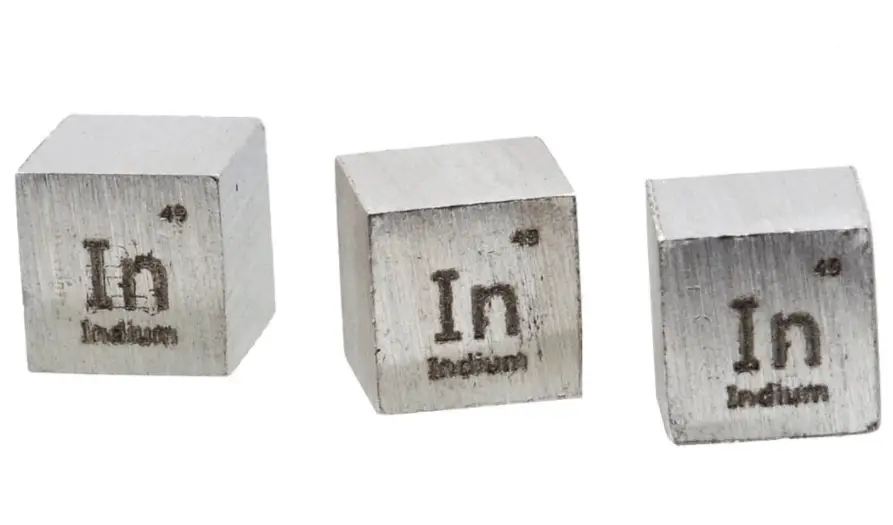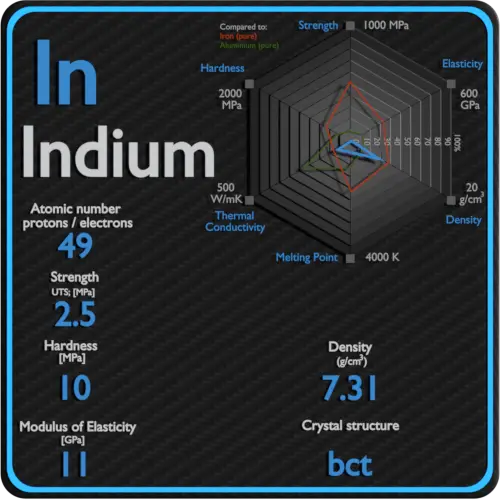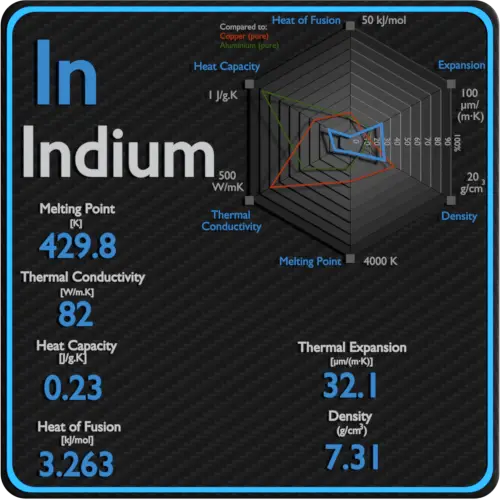About Indium
Indium is a post-transition metal that makes up 0.21 parts per million of the Earth’s crust. Very soft and malleable, indium has a melting point higher than sodium and gallium, but lower than lithium and tin. Chemically, indium is similar to gallium and thallium.
Summary
| Element | Indium |
| Atomic number | 49 |
| Element category | Poor Metal |
| Phase at STP | Solid |
| Density | 7.31 g/cm3 |
| Ultimate Tensile Strength | 2.5 MPa |
| Yield Strength | 1 MPa |
| Young’s Modulus of Elasticity | 11 GPa |
| Mohs Scale | 1.2 |
| Brinell Hardness | 10 MPa |
| Vickers Hardness | N/A |
| Melting Point | 156.6 °C |
| Boiling Point | 2072 °C |
| Thermal Conductivity | 82 W/mK |
| Thermal Expansion Coefficient | 32.1 µm/mK |
| Specific Heat | 0.23 J/g K |
| Heat of Fusion | 3.263 kJ/mol |
| Heat of Vaporization | 231.5 kJ/mol |
| Electrical resistivity [nanoOhm meter] | 83.7 |
| Magnetic Susceptibility | −64e-6 cm^3/mol |
Applications of Indium
The primary consumption of indium worldwide is LCD production. Demand rose rapidly from the late 1990s to 2010 with the popularity of LCD computer monitors and television sets, which now account for 50% of indium consumption. It is most notably used in the semiconductor industry, in low-melting-point metal alloys such as solders, in soft-metal high-vacuum seals, and in the production of transparent conductive coatings of indium tin oxide (ITO) on glass. Indium is considered a technology-critical element.
Production and Price of Indium
Raw materials prices change daily. They are primarily driven by supply, demand and energy prices. In 2019, prices of pure Indium were at around 600 $/kg.
Indium is produced mainly from residues generated during zinc ore processing. In the middle and late 1980’s, the development of indium phosphide semiconductors and indium-tin-oxide thin films for Liquid Crystal Displays (LCD) aroused much interest. By 1992, the thin-film application had become the largest end use. The amount of indium consumed is largely a function of worldwide LCD production. Increased manufacturing efficiency and recycling (especially in Japan) maintain a balance between demand and supply. Its main source material are sulfidic zinc ores, where it is mostly hosted by sphalerite.
Source: www.luciteria.com
Mechanical Properties of Indium
Strength of Indium
In mechanics of materials, the strength of a material is its ability to withstand an applied load without failure or plastic deformation. Strength of materials basically considers the relationship between the external loads applied to a material and the resulting deformation or change in material dimensions. In designing structures and machines, it is important to consider these factors, in order that the material selected will have adequate strength to resist applied loads or forces and retain its original shape. Strength of a material is its ability to withstand this applied load without failure or plastic deformation.
For tensile stress, the capacity of a material or structure to withstand loads tending to elongate is known as ultimate tensile strength (UTS). Yield strength or yield stress is the material property defined as the stress at which a material begins to deform plastically whereas yield point is the point where nonlinear (elastic + plastic) deformation begins.
See also: Strength of Materials
Ultimate Tensile Strength of Indium
Ultimate tensile strength of Indium is 2.5 MPa.
Yield Strength of Indium
Yield strength of Indium is 1 MPa.
Modulus of Elasticity of Indium
The Young’s modulus of elasticity of Indium is 1 MPa.
Hardness of Indium
In materials science, hardness is the ability to withstand surface indentation (localized plastic deformation) and scratching. Brinell hardness test is one of indentation hardness tests, that has been developed for hardness testing. In Brinell tests, a hard, spherical indenter is forced under a specific load into the surface of the metal to be tested.
Brinell hardness of Indium is approximately 10 MPa.
The Vickers hardness test method was developed by Robert L. Smith and George E. Sandland at Vickers Ltd as an alternative to the Brinell method to measure the hardness of materials. The Vickers hardness test method can be also used as a microhardness test method, which is mostly used for small parts, thin sections, or case depth work.
Vickers hardness of Indium is approximately N/A.
Scratch hardness is the measure of how resistant a sample is to permanent plastic deformation due to friction from a sharp object. The most common scale for this qualitative test is Mohs scale, which is used in mineralogy. The Mohs scale of mineral hardness is based on the ability of one natural sample of mineral to scratch another mineral visibly.
Indium is has a hardness of approximately 1.2.
See also: Hardness of Materials
Indium – Crystal Structure
A possible crystal structure of Indium is body-centered tetragonal structure.
In metals, and in many other solids, the atoms are arranged in regular arrays called crystals. A crystal lattice is a repeating pattern of mathematical points that extends throughout space. The forces of chemical bonding causes this repetition. It is this repeated pattern which control properties like strength, ductility, density, conductivity (property of conducting or transmitting heat, electricity, etc.), and shape. There are 14 general types of such patterns known as Bravais lattices.
See also: Crystal Structure of Materials
Crystal Structure of Indium

Thermal Properties of Indium
Indium – Melting Point and Boiling Point
Melting point of Indium is 156.6°C.
Boiling point of Indium is 2072°C.
Note that, these points are associated with the standard atmospheric pressure.
Indium – Thermal Conductivity
Thermal conductivity of Indium is 82 W/(m·K).
The heat transfer characteristics of a solid material are measured by a property called the thermal conductivity, k (or λ), measured in W/m.K. It is a measure of a substance’s ability to transfer heat through a material by conduction. Note that Fourier’s law applies for all matter, regardless of its state (solid, liquid, or gas), therefore, it is also defined for liquids and gases.
Coefficient of Thermal Expansion of Indium
Linear thermal expansion coefficient of Indium is 32.1 µm/(m·K)
Thermal expansion is generally the tendency of matter to change its dimensions in response to a change in temperature. It is usually expressed as a fractional change in length or volume per unit temperature change.
Indium – Specific Heat, Latent Heat of Fusion, Latent Heat of Vaporization
Specific heat of Indium is 0.23 J/g K.
Heat capacity is an extensive property of matter, meaning it is proportional to the size of the system. Heat capacity C has the unit of energy per degree or energy per kelvin. When expressing the same phenomenon as an intensive property, the heat capacity is divided by the amount of substance, mass, or volume, thus the quantity is independent of the size or extent of the sample.
Latent Heat of Fusion of Indium is 3.263 kJ/mol.
Latent Heat of Vaporization of Indium is 231.5 kJ/mol.
Latent heat is the amount of heat added to or removed from a substance to produce a change in phase. This energy breaks down the intermolecular attractive forces, and also must provide the energy necessary to expand the gas (the pΔV work). When latent heat is added, no temperature change occurs. The enthalpy of vaporization is a function of the pressure at which that transformation takes place.
Indium – Electrical Resistivity – Magnetic Susceptibility
Electrical property refers to the response of a material to an applied electric field. One of the principal characteristics of materials is their ability (or lack of ability) to conduct electrical current. Indeed, materials are classified by this property, that is, they are divided into conductors, semiconductors, and nonconductors.
See also: Electrical Properties
Magnetic property refers to the response of a material to an applied magnetic field. The macroscopic magnetic properties of a material are a consequence of interactions between an external magnetic field and the magnetic dipole moments of the constituent atoms. Different materials react to the application of magnetic field differently.
See also: Magnetic Properties
Electrical Resistivity of Indium
Electrical resistivity of Indium is 83.7 nΩ⋅m.
Electrical conductivity and its converse, electrical resistivity, is a fundamental property of a material that quantifies how Indium conducts the flow of electric current. Electrical conductivity or specific conductance is the reciprocal of electrical resistivity.
Magnetic Susceptibility of Indium
Magnetic susceptibility of Indium is −64e-6 cm^3/mol.
In electromagnetism, magnetic susceptibility is the measure of the magnetization of a substance. Magnetic susceptibility is a dimensionless proportionality factor that indicates the degree of magnetization of Indium in response to an applied magnetic field.


























